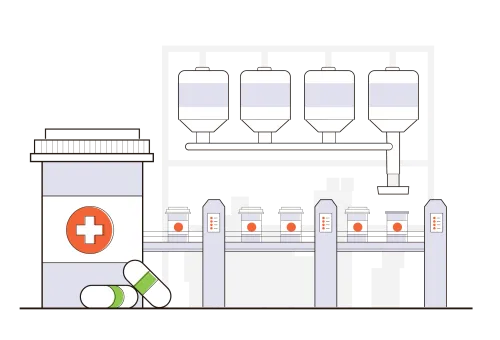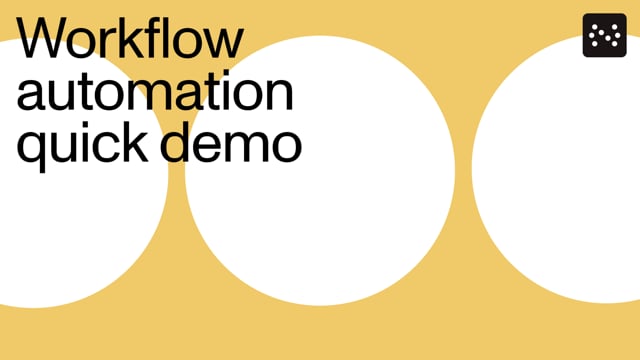Workflow Automation for Pharmaceuticals and Biotech
Table of contents

Pharmaceutical and biotech industries face unique challenges due to their complex regulatory environment. Automation can help these industries meet regulatory and compliance requirements, go to market faster, eliminate low-value work, provide complete workflow visibility, and improve communication.
The pharmaceutical and biotech industries operate in a complex regulatory environment, which presents unique challenges. Workflow automation can help these industries drive efficiency, accuracy, and productivity. Here's how:
Meet Regulatory and Compliance Requirements
With automation, standard operating procedures will be done the same way – every time. Complying with rules and regulations is not optional. Complying with significant regulatory oversight and legislation, like Sarbanes-Oxley and HIPAA, can create enormous obstacles without the right tools being used in your organization. With automation, it’s possible to enforce consistent processes that match policies and procedures within the organization.
Go to Market Faster
With automation – errors are significantly reduced and, through guaranteed checks and oversight, can be eliminated. Automation helps organizations go to market faster by saving time and reducing errors. The improved speed, quality, and efficiency of approving new products mean that development can begin faster.
Eliminate Low-Value Work
Employees can focus on higher-value projects by letting automation take over the repetitive, low-value tasks. Examples of low-value work could be waiting on an email chain of approvals or reminding coworkers to review content.
Rather than tracking down documents for approval, automation will keep track of tasks and flow immediately to the next step based on intelligent business rules, saving hours each week. This way, your employees can get back to what matters.
Full Workflow Visibility
Processes and approvals are tracked the whole time during the automated process. Complete visibility of where the document is, whom it's assigned to, where bottlenecks might be, and a complete audit trail is always available.
Communicate Better
Communication is frictionless with automation. Rules can be set throughout to keep managers and stakeholders aware of what is happening in processes. In contrast, stakeholders may have needed more visibility into these milestones in the past. With improved internal and external visibility, communication can flow openly to improve overall organization success.
Use Case Examples

Product Development
Bio/pharma companies face challenges with global expansion, increased competition, regulatory changes, and evolving consumer expectations. Accelerating new products to market is crucial to keep up with these demands. However, creating new products remains a complex and challenging task.
While it is impossible to shorten the product development cycle, it can be managed more effectively with workflow management. By establishing a structured workflow encompassing R&D, Quality, Production, Trials, Packaging, RA, and Marketing, bio/pharma companies can minimize risks, ensure compliance, and eliminate process bottlenecks. This results in a faster time-to-market for products.
Disclosure Approval Process
Bio/pharma companies require rigorous approval before publicizing clinical data, documents, or other materials. This process involves committees, executives, and multiple staff members. However, this process is often handled manually, which can limit efficiency. Approvers need help handling requests, while stakeholders need more visibility into milestones. This can result in improperly approved recommendations or stakeholders bypassing the established process.
A workflow management system can streamline the disclosure approval process by automating request and approval tasks based on preset rules set by the organization. Disclosure approval requests can be easily entered through a portal or from third-party systems. Requests move from step to step through the approval process without the need for re-entering information. Meanwhile, a complete view of the request status is available to all stakeholders from beginning to end. Nutrient Workflow ensures full compliance with your Disclosure Approval Process while providing an audit trail of each submitted request.
Vendor Qualification
Bio/Pharma companies are responsible for ensuring that outside vendors and contractors are appropriately qualified. To achieve this, workflow management should be incorporated into selecting vendors or material suppliers. This will provide accountability and consistency and reduce the risk of inconsistent vendor approval processes. A workflow management system consistently screens and properly approves vendors to work with the company. In addition, a separate workflow process can handle the initiation of contracts. This ensures that hierarchy levels review and approve new relationships or project contracts.
Regulatory Requests
Any requests that involve the regulatory process should be standardized and tracked, including Request For Regulatory Services, Request for Regulatory Projects, Request For Regulatory Payment, Pharmacovigilance Tracking, etc. This can all be done through workflow automation.
For pharma and bioscience companies, workflow automation is no longer a luxury—it's a necessity. Learn how workflow automation can help improve efficiency, accuracy, and compliance. Request a demo to get a personalized look at how Nutrient Workflow will benefit your organization, or start by downloading our free guide, Workflow Automation Guide for Pharma and Biosciences.(opens in a new tab)
Watch Our 2-Minute Demo.








